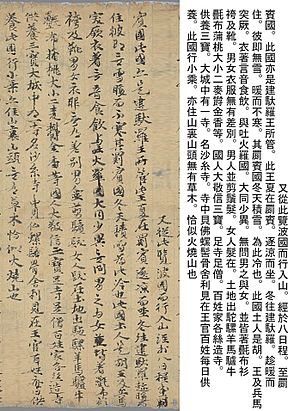Hyecho facts for kids
Quick facts for kids Hyecho |
|
| Hangul |
혜초
|
|---|---|
| Hanja |
慧超 also 惠超
|
| Revised Romanization | Hyecho |
| McCune–Reischauer | Hyech'o |
Hyecho (704–787) was a Buddhist monk from Silla, one of the ancient Three Kingdoms of Korea. His Sanskrit name was Prajñāvikrama, and in Chinese, he was known as Hui Chao.
Hyecho studied a special kind of Buddhism in Tang China. His teachers were the Indian monks Śubhakarasiṃha and Vajrabodhi. Vajrabodhi thought Hyecho was very smart, saying he was one of the few people who knew a lot about Buddhist teachings. In 723, his teachers told him to travel to India. They wanted him to learn more about the language and culture of the land where Buddha lived.
Contents
Hyecho's Journey to India
During his trip to India, Hyecho wrote a travel diary in Chinese. It was called "Memoir of the pilgrimage to the five kingdoms of India". This book tells us about his amazing journey.
Hyecho first arrived in India by sea. He then traveled to the Indian Kingdom of Magadha (which is now Bihar). From there, he visited important places like Kushinagar and Varanasi. His journey continued north to Lumbini (in present-day Nepal), Kashmir, and even lands where Arabs lived.
Hyecho left India by following the famous Silk Road towards the west. He passed through places like Agni or Karasahr. His journey ended in China in 729 CE. It took him about four years to complete this long trip.
What Hyecho Saw in India
Hyecho's travel diary shares many interesting details. He wrote about the local food, languages, weather, cultures, and political situations. He noticed that Buddhism was becoming less popular in India. He also found it interesting to see cattle walking freely in cities and villages.
Hyecho wrote about three kingdoms northeast of Kashmir. He said these places were controlled by the Tibetans. He described them as small and rugged, with many monasteries and monks. The people there believed strongly in the Three Jewels of Buddhism. However, he noted that in Tibet itself, there were no monasteries, and Buddha's teachings were not known.
This part of his diary is important. It shows that in the early 700s, the area of modern Ladakh was under Tibetan control. It also tells us that the people living there were not Tibetan.
Rediscovering Hyecho's Book
Hyecho's travel diary was lost for many years. But in 1908, a part of it was found again. Paul Pelliot discovered a fragment of the book in the Mogao Caves in China. This piece of the original book is now kept in France. Over the years, it has been translated into many different languages.
Hyecho's Visit to Jibin
Hyecho visited a place called Jibin (an old kingdom also known as Kapisa) in 726 CE. He wrote about what he saw there.
"又從此覽波國而行入山。經於八日程。至罽賓國。此國亦是建馱羅王所管。此王夏在罽賓。逐涼而坐。冬往建馱羅。趁暖而住。彼即無雪。暖而不寒。其罽賓國冬天積雪。為此冷也。此國土人是胡。王及兵馬突厥。衣著言音食飲。與吐火羅國。大同少異。無問男之與女。並皆著[疊*毛]布衫袴及靴。男女衣服無有差別。男人並剪鬚髮。女人髮在。土地出駝騾羊馬驢牛[疊*毛]布蒲桃大小二麥欝金香等。國人大敬信三寶。足寺足僧。百姓家各絲造寺。供養三寶。大城中有一寺。名沙糸寺。寺中貝佛螺髻骨舍利見在王官百姓每日供養。此國行小乘。亦住山裏山頭無有草木。恰似火燒山也".Hyecho wrote that the country of Jibin was ruled by a Turkic King. This king and his important people practiced Buddhism. He noted that the king would move between Jibin and Gandhara to find cooler or warmer weather.
He described the people of Jibin as "Hu" (a term for non-Chinese people). The king and his soldiers were Turkic. Their clothes, language, and food were similar to those in Tokharistan. Men and women wore cotton shirts, trousers, and boots, with no difference in their clothing. Men cut their beards and hair, but women kept their hair long.
The land produced camels, mules, sheep, horses, and cotton cloth. It also grew grapes, barley, wheat, and saffron. Hyecho observed that the people greatly respected the Three Jewels of Buddhism. There were many monasteries and monks. Ordinary people built monasteries and supported Buddhist teachings. In the main city, there was a monastery called Sha-hsi-ssu. Here, people could see a special part of the Buddha's head (like a bun) and his bone relics. The king, officials, and common people worshipped these relics daily. A type of Buddhism called Hinayana was practiced there. The land was mountainous, and the mountains had no plants, looking as if they had been burned.
—Original text and translation of the Hyecho on Jibin.


